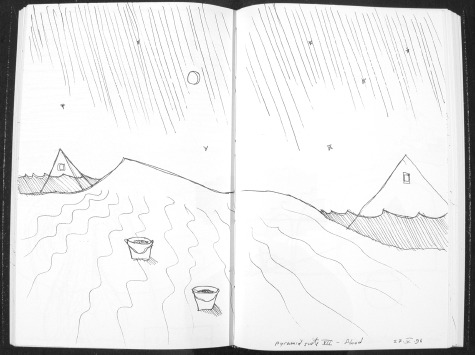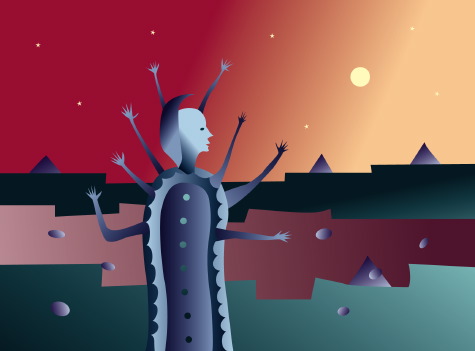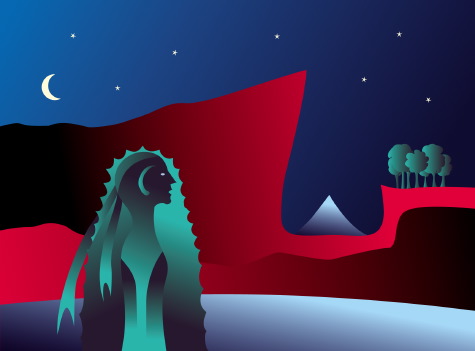Pyramid Suite was my first body of digital work, comprising twenty-four pieces completed between November 1996 and March or July 1997. The series started as eight sketchbook drawings, complete with titles, which I had done on 27 May 1996.1 As I completed the digital versions of these first eight sketches, I searched for related sketches that could be brought into the series, as well as creating new drawings to add to what I already had. With the subsequent images I decided on a title after choosing a sketch but before starting the digital piece. The serial numbers are just that: they indicate the order in which each piece was completed.
When I made the first sketches, I hadn’t specifically intended for this to be a digital series. In fact, I do very few of my sketchbook drawings with a clear idea of how I will develop them into “fully-produced” pieces. Drawing is usually simply a case of being in the moment. When I approach my sketchbooks to look for drawings to interpret in other media it is more as an editor or curator.
In terms of imagery, I was dealing with the ongoing theme of anthropomorphic figures in landscapes, in this case anchoring the setting by using the image of one or more pyramids. Each piece also has the moon and seven stars in the sky. As with the pyramid image, these celestial bodies have symbolic meaning independent of my use of them but are used primarily for their role as visual anchors across the series. The stars can be interpreted as those of the constellation Ursa Major (the Big Dipper) or as the Pleiades star cluster (also known as the Seven Sisters). But while I had considered these meanings for “seven stars” while making the work, for me the intentional meaning in these symbols—and this meaning is secondary to their formal compositional role—comes from elsewhere. My own explanation of the symbolism—which I’m including here for the sake of trivia—comes mainly from a story my father told me many years ago when I asked him about the engraved decoration on a Chinese ceremonial sword he had acquired on one of his research trips. According to this story, the seven connected stars engraved on the blade symbolized one of the aforementioned constellations, and represented the home of the gods in the Chinese pantheon. My reference to this story in making these images came about because I liked the idea of ascribing a kind of ceremonial power to my images, but at the same time I didn’t attach a great deal of ritual significance to the act because it is not a core part of my worldview.
As for technical concerns, I was exploring the possibilities available within the constraints of opaque shapes filled with colour gradients using Adobe Illustrator.2 In contrast to the line-based source drawings, I wanted to use only filled areas of colour without any line work. I also wanted to create more depth and nuance than is usual with images created using this software, hence my use of gradients—smooth blends from one colour to another. My process consisted of scanning in each line drawing and retracing it with a combination of mouse and tablet drawing, then adjusting and colouring the compositions.
The images have proportions close to the aspect ratio of television.3 For the purposes of comparison, the 4:3 aspect ratio of television can also be written as 1.33:1. The aspect ratio of the images in Pyramid Suite is 1.35:1, which is close enough to almost be a mathematical rounding error. I’ve given the dimensions of these pieces as an aspect ratio because even though the pieces were made at specific dimensions in the software, they are intended for larger display. The program I used allows me to scale the images to any size based on the specifications of the output medium—postage stamp to billboard and beyond—without losing sharpness or image quality. I arrived at these proportions based on a combination of factors: the dimensions of the source sketches (10″ x 8″ or 25cm x 20cm), what looked good on the screen, and what would fit on my tiny 13-inch monitor with all of the control palettes of my software. As well, even though my intention was for larger-scale display, Illustrator does require a commitment to physical dimensions. The document image sizes for each of these pieces is 5.5″ x 4″ (13.75cm x 10cm), which in addition to being close to the proportions of my sketches, was a suitable compromise within the performance constraints of the Macintosh IIci I was using to make the pieces.
Pyramid Suite made its online debut in 1997 on a site I set up for this purpose on Geocities.4 I later moved the work my own site once I had set up my spiraldragon.com web domain.
In the collection of images that follows I have included the original eight sketches alongside the corresponding finished pieces, and the remaining sixteen pieces without their sketches. Most of the pieces are very similar to the sketches, though in some cases there are significant differences. For example, the figure in Pyramid Suite 7: Flood has been imported from Pyramid Suite 3: Magician, and the right-hand figure in the sketch for Pyramid Suite 3: Magician has been flipped to fill the space emptied by the removal of the left-hand figure.

Pyramid Suite 1: Pathways (completed between 1996-1997)
Digital media, variable size (1.35:1 aspect ratio)

Original sketch for Pyramid Suite 1: Pathways (27 May 1996)
Ink on Paper, 5.5″ x 8.5″

Pyramid Suite 2: Messenger (completed between 1996-1997)
Digital media, variable size (1.35:1 aspect ratio)

Original sketch for Pyramid Suite 2: Messenger (27 May 1996)
Ink on Paper, 5.5″ x 8.5″

Pyramid Suite 3: Magician (completed between 1996-1997)
Digital media, variable size (1.35:1 aspect ratio)

Original sketch for Pyramid Suite 3: Magician (27 May 1996)
Ink on Paper, 5.5″ x 8.5″

Pyramid Suite 4: Effigy (completed between 1996-1997)
Digital media, variable size (1.35:1 aspect ratio)

Original sketch for Pyramid Suite 4: Effigy (27 May 1996)
Ink on Paper, 5.5″ x 8.5″

Pyramid Suite 5: Temple (completed between 1996-1997)
Digital media, variable size (1.35:1 aspect ratio)

Original sketch for Pyramid Suite 5: Temple (27 May 1996)
Ink on Paper, 5.5″ x 8.5″

Pyramid Suite 6: The Ten Thousand Steps (completed between 1996-1997)
Digital media, variable size (1.35:1 aspect ratio)

Original sketch for Pyramid Suite 6: The Ten Thousand Steps (27 May 1996)
Ink on Paper, 5.5″ x 8.5″

Pyramid Suite 7: Flood (completed between 1996-1997)
Digital media, variable size (1.35:1 aspect ratio)

Original sketch for Pyramid Suite 7: Flood (27 May 1996)
Ink on Paper, 5.5″ x 8.5″

Pyramid Suite 8: She Watches, She Waits to Fly (completed between 1996-1997)
Digital media, variable size (1.35:1 aspect ratio)

Original sketch for Pyramid Suite 8: She Watches, She Waits to Fly (27 May 1996)
Ink on Paper, 5.5″ x 8.5″

Pyramid Suite 9: Water Dreams (completed between 1996-1997)
Digital media, variable size (1.35:1 aspect ratio)

Pyramid Suite 10: Sphinx (completed between 1996-1997)
Digital media, variable size (1.35:1 aspect ratio)

Pyramid Suite 11: Bridge (completed between 1996-1997)
Digital media, variable size (1.35:1 aspect ratio)

Pyramid Suite 12: Reptile (completed between 1996-1997)
Digital media, variable size (1.35:1 aspect ratio)

Pyramid Suite 13: Dancer (completed between 1996-1997)
Digital media, variable size (1.35:1 aspect ratio)

Pyramid Suite 14: Dawn (completed between 1996-1997)
Digital media, variable size (1.35:1 aspect ratio)

Pyramid Suite 15: Metropolis (completed between 1996-1997)
Digital media, variable size (1.35:1 aspect ratio)

Pyramid Suite 16: Wanderer (completed between 1996-1997)
Digital media, variable size (1.35:1 aspect ratio)

Pyramid Suite 17: Offering (completed between 1996-1997)
Digital media, variable size (1.35:1 aspect ratio)

Pyramid Suite 18: Dreamtime (completed between 1996-1997)
Digital media, variable size (1.35:1 aspect ratio)

Pyramid Suite 19: Solitude (completed between 1996-1997)
Digital media, variable size (1.35:1 aspect ratio)

Pyramid Suite 20: Rooting (completed between 1996-1997)
Digital media, variable size (1.35:1 aspect ratio)

Pyramid Suite 21: Diva (completed between 1996-1997)
Digital media, variable size (1.35:1 aspect ratio)

Pyramid Suite 22: Conjuress (completed between 1996-1997)
Digital media, variable size (1.35:1 aspect ratio)

Pyramid Suite 23: Grove (completed between 1996-1997)
Digital media, variable size (1.35:1 aspect ratio)

Pyramid Suite 24: Encounter (completed between 1996-1997)
Digital media, variable size (1.35:1 aspect ratio)
FOOTNOTES
- That I titled each drawing as I completed it is significant in light of the fact that titling is such a laborious process for me. Essay 5 (From the Nonverbal to the Verbal: Titles as Translation and Interpretation) in my 13 1/2 Essays On Practice explores in detail my approach to titling work. ^
- I explain my reasons for choosing digital media, and specifically the vector-based graphic format of Adobe Illustrator in my 13 1/2 Essays On Practice, specifically Essay 7 (Why Did I Go Digital?) and to a lesser extent Essay 9 (Technologically-Assisted Mimicry). ^
- Aspect ratios for television screens—as well as computer monitors and movie screens—are a comparison of the screen’s width to height. ^
- Geocities was a company that was trying to build special-interest web communities by giving free hosting to people who were willing to build and maintain their own web pages and, of course, display advertising on all of these pages. The first version of my Geocities site went online around December 1996—in the early days of the dotcom boom—before personal web domains were common, and before Geocities started playing tricks with its terms of service. These tricks, which included phrasing that would give the company perpetual non-exclusive rights to make copies or derivative works of all hosted content—without consent or compensation—irked enough users that the company eventually recanted and re-revised their terms in more user-friendly language. All of this was long before the company was sold to Yahoo. ^
Pingback: Melissa, the sage enchantress « Rosettasister’s Weblog